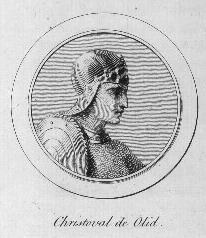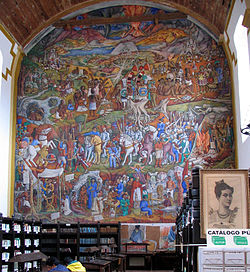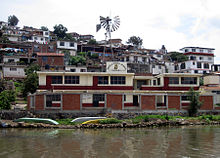Purépecha
This article needs additional citations for verification. (January 2024) |
Roman Catholicism ,
Purépecha religion |
The Purépecha (
They are also known by the derogatory term "
The Purépecha occupied most of Michoacán but also some of the lower valleys of both
History
Prehispanic history
It was one of the major empires of the Pre-Columbian era. The capital city was Tzintzuntzan. Purépecha architecture is noted for step pyramids in the shape of the letter "T". Pre-Columbian Purépecha artisans made feather mosaics that extensively used hummingbird feathers, which were highly regarded as luxury goods throughout the region.
During the Pre-Colonial era, the Purépecha kingdom engaged in conflict with the Aztecs. The Purépecha kingdom expanded through conquest. However, many avoided conquest and bloodshed and, in order to maintain their freedom, exchanged goods and resources such as metal with the Purépecha kingdom.[2]
The Purépecha empire was never conquered by the Aztec Empire, in fact there is no record of the Aztecs ever defeating them in battle. This was most likely due to the presence of metal ores within their empire, and their knowledge of metallurgy, which was far superior to that of the Aztecs [1][failed verification]; such skills have persisted in their descendants and are still widely regarded today, particularly their coppersmithing. Even though they were enemies with the Aztecs, the Aztecs still traded with them, mainly for metal tools and weapons.
Spanish era (1525-1821)

After hearing of the
Then, in 1530, the president of the
Post-independence history
Cárdenas era


Following the Mexican Revolution (1910–1920), Michoacán experienced political unrest. When former revolutionary general Lázaro Cárdenas, originally from a small town in Michoacán, was appointed governor of his state, he began an ambitious program of reform and economic development, which he continued when he became president of Mexico (1934–40). For him, the indigenous heritage of Michoacán was foundational for the construction of Mexico's post-revolutionary identity. Although the Aztecs loomed large in Mexican history and the construction of identity, Cárdenas saw the Purépecha as "purer" source. The Purépecha had never been conquered by the Aztecs, but in the era of the Spanish conquest, the resistance of the Purépecha was a point of regional pride. In particular, Cárdenas promoted the story of Princess Eréndira who is said to have fought against the Spanish.[4] He named the house he built in Pátzcuaro "La Quinta Eréndira" and commissioned muralists to depict Purépecha history in his residence and elsewhere.[5] Purépecha traditions of folkloric performance became a source of indigenista pride.[6]

Out-migration from Michoacán
In the late twentieth and early twenty-first century social scientists have studied Purépecha out-migration from the region.[7][8]
Religion
Many traditions live on, including the Jimbani Uexurhina (New Fire), which is celebrated on February 2. It has both traditional indigenous and
Culture

The Purépecha are mainly fishers because they mainly lived around the Patzcuaro lakes. They are also known for their skill in weaving and pottery. Many live in wooden cabins within compounds surrounded by dry-stone walls. However, many of these structures are being replaced with homes made out of brick and concrete. One distinctive practice of the Purépecha include the baptism of newborns after forty days of separate rest for the mother and child. The infant is then swaddled for six weeks and kept in physical contact with the mother or a close female relative.[10] Temples created by Purépecha didn't look like their Mesoamerica counterparts.[11]
Purépecha today celebrates many holidays. One of the most popular holidays celebrated by the Purépecha is the Day Of The Dead or "Día De Los Muertos" . While it is celebrated throughout Mexico in the same way, Purépechans celebrate slightly differently. On November 1 and 2, family members take part in all-night vigils at the graves of their loved ones. Purépecha believe that the souls of the dead watch over their living relatives on the Day of the Dead.[12]
In the town of San Juan Nuevo Parangaricutiro, which is a Purépecha town, unmarried men will dance the Dance of the Cúrpites. The dance is used to help the man express their masculinity and court their sweetheart.[13] The dance is celebrated during the Christian holiday of Epiphany.
Language

The Purépecha language is spoken by nearly 200,000 people in Michoacán. Since Mexico's 2000 indigenous language law, indigenous languages like Purépecha were granted official status equal with Spanish in the areas in which they are spoken. Recently, educational instruction in Purépecha has been introduced in the local school systems. Additionally, many Purépecha communities offer classes and lessons in the language.
In popular culture
Princess Eréndira of the Purépecha was depicted in the 2006 film Erendira Ikikunari (Erendira the Untamable).
The 2017 Disney film, Coco presents a character named “Mama Coco”, who was apparently based on the real Purépecha woman María Salud Ramírez Caballero, although it was never officially confirmed by Pixar.[14]
The 2022 film, Black Panther: Wakanda Forever, introduces Namor, whose mythos is rewritten to include an indigenous Meso American background with influences from Mayan and Aztec culture. Tenoch Huerta, who portrays Namor, comes from a Purépecha background.
See also
References
- ^ "Purépecha". 26 December 2016.
- ^ Haskell, David (2018). The Tarascan Kingdom and Its Prehispanic Past in Mesoamerican Context. University Press of Colorado. pp. 50–79.
- ^ "Research paper" (PDF). www.unesco.org.uy (in Spanish).
- ^ *Ramírez Barreto, Ana Cristina, "'Eréndira a caballo': Acoplamiento de cuerpos e historias en un relato de conquista y resistencia". e-misférica: Sexualities and Politics in the Americas, 2 no. 2 (2005)1-19.
- ^ Jolly, Jennifer. Creating Pátzcuaro, Creating Mexico: Art, Tourism, and Nation Building Under Lázaro Cárdenas. Austin: University of Texas Press 2018
- ^ Hellier-Tinoco, Ruth. Embodying Mexico: Tourism, Nationalism, and Performance. New York: Oxford University Press 2011.
- ^ Anderson, Warren. "P'urépecha migration into the US Rural Midwest: History and current trends." Indigenous Mexican Migrants in the United States, edited by Jonathan Fox and Gaspar Rivera-Salgado, La Jolla: University of California, San Diego, Center for Comparative Immigration Studies/Center for US-Mexican Studies (2004).
- ^ Marr, Paul, and Christopher Sutton. "Demographic changes in the Purepecha region of Michoacan, Mexico: 1970-2000." Journal of Latin American Geography (2004): 52-66.
- ^ "The Purepecha of Michoacan - Purepecha - Mexico Guru". www.mexicoguru.com. Retrieved 2022-02-07.
- ISBN 0-7566-0520-2.
- JSTOR 215553.
- ^ Brandes, Stanley (1998). "Day of The Dead". Credo Reference. Retrieved April 4, 2022.
- ^ Bishop, Joyce M. (2009). ""Those who gather in": An indigenous ritual dance in the context of contemporary Mexican transnationalism". Journal of American Folklore. 122 (486).
- ^ Crowther, Linnea (2022-10-18). "María Salud Ramírez Caballero obituary: "Real Life Mamá Coco" dies at 109". Legacy.com. Retrieved 2024-01-17.
Further reading
- Anderson, Warren. "P'urépecha migration into the US Rural Midwest: History and current trends." Indigenous Mexican Migrants in the United States, edited by Jonathan Fox and Gaspar Rivera-Salgado, La Jolla: University of California, San Diego, Center for Comparative Immigration Studies/Center for US-Mexican Studies (2004).
- Bellamy, K. R. "On the external relations of Purepecha: an investigation into classification, contact and patterns of word formation." Diss. 2018.
- Boyd, Maurice. Tarascan myths & legends: a rich and imaginative history of the Tarascans. No. 4. Texas Christian University Press, 1969.
- Boyd, Maurice. Eight Tarascan Legends. No. 3. University of Florida, 1958.
- Brand, Donald D. "An Historical Sketch of Geography and Anthropology in the Tarascan Region: Part I." New Mexico Anthropologist 6.2 (1943): 37–108.
- Bush, Jason W. "Architectural patterning in the Purepecha heartland: An intrasite settlement study at the urban center of Sacapu Angamuco, Michoacán, México." Diss. Colorado State University, 2012.
- Carot, Patricia, and Marie-Areti Hers. "Epic of the Toltec Chichimec and the Purepecha in the Ancient Southwest." Archaeology without Borders. Contact, Commerce, and Change in the US Southwest and Northwestern Mexico, Boulder, University Press of Colorado (2008): 301–334.
- Chamoreau, Claudine. "Dialectology, typology, diachrony, and contact linguistics: A multi-layered perspective in Purepecha." STUF-Language Typology and Universals Sprachtypologie und Universalienforschung 65.1 (2012): 6-25.
- Cohen, Anna S., and Christopher Fisher. "The Tarascan (Purépecha) Empire." The Oxford Handbook of the Aztecs.
- Godinez, Isaura. "Migration and Health Outcomes in Purepecha Sending Communities." PhD Diss. The University of North Carolina at Chapel Hill, 2016.
- Haskell, David L. "From Tribute to Communal Sovereignty: The Tarascan and Caxcan Territories in Transition." The Canadian Journal of Native Studies 35.2 (2015): 265.
- Haskell, David Louis. "History and the construction of hierarchy and ethnicity in the prehispanic Tarascan state: a syntagmatic analysis of the Relación de Michoacán." Diss. University of Florida, 2003.
- Hellier-Tinoco, Ruth. Embodying Mexico: Tourism, Nationalism, and Performance. New York: Oxford University Press 2011.
- Jolly, Jennifer. Creating Pátzcuaro, Creating Mexico: Art, Tourism, and Nation Building Under Lázaro Cárdenas. Austin: University of Texas Press 2018. ISBN 978-1477-314203
- Kemper, Robert V., and Julie Adkins. "From the" Modern Tarascan Area" to the" Patria Purépecha: Changing Concepts of Ethnic and Regional Identity."." (2006).
- Krippner-Martínez, James. "The politics of conquest: An interpretation of the Relación de Michoacán." The Americas 47.2 (1990): 177–197.
- Marr, Paul, and Christopher Sutton. "Demographic changes in the Purepecha region of Michoacan, Mexico: 1970-2000." Journal of Latin American Geography (2004): 52–66.
- Marr, Paul, and Christopher Sutton. "Impacts of Transportation Changes on the Woodworking Industry of Mexico's Purépecha Region." Geographical Review 94.4 (2004): 440–461.
- Pollard, Helen Perlstein. "The construction of ideology in the emergence of the prehispanic Tarascan state." Ancient Mesoamerica 2.2 (1991): 167–179.
- Pollard, Helen Perlstein. "A model of the emergence of the Tarascan State." Ancient Mesoamerica 19.2 (2008): 217–230.
- Ragone, Agnes, and Paul Marr. "Language maintenance in the Meseta Purépecha region of Michoacán, Mexico." Anthropological linguistics (2006): 109–131.
- Ramírez Barreto, Ana Cristina, "'Eréndira a caballo': Acoplamamiento de Cuerpos e historias en un relato de conquista y resistencia."e-misférica: Performance and Politics in the Americas, 2 no. 2 (2005)1-19.
- Roskamp, Hans. "Tarascan (P'urhépecha) Empire." The Encyclopedia of Empire (2016): 1–3.
- Roth-Seneff, Andrew, Robert V. Kemper, and Julie Adkins, eds. From Tribute to Communal Sovereignty: The Tarascan and Caxcan Territories in Transition. University of Arizona Press, 2016.
- Silverstein, Jay E. "A Study of the Late Postclassic Aztec-Tarascan Frontier in Northern Guerrero, Mexico: The Oztuma-Cutzamala Project." (2000).
- Thurtell, Joel, and Emily Klancher Merchant. "Gender-Differentiated Tarascan Surnames in Michoacán." Journal of Interdisciplinary History 48.4 (2018): 465–483.
